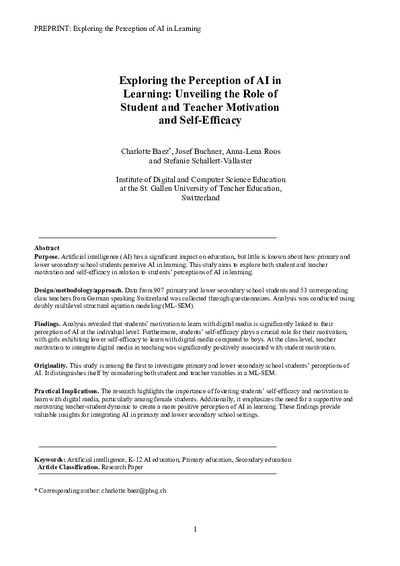Exploring the Perception of AI in LearningUnveiling the Role of Student and Teacher Motivation and Self-Efficacy
Publikationsdatum:
|
 |
 Diese Seite wurde seit 2 Jahren inhaltlich nicht mehr aktualisiert.
Unter Umständen ist sie nicht mehr aktuell.
Diese Seite wurde seit 2 Jahren inhaltlich nicht mehr aktualisiert.
Unter Umständen ist sie nicht mehr aktuell.
 Zusammenfassungen
Zusammenfassungen

Purpose. Artificial intelligence (AI) has a significant impact on education, but little is known about how primary and lower secondary school students perceive AI in learning. This study aims to explore both student and teacher motivation and self-efficacy in relation to students’ perceptions of AI in learning.
Design/methodology/approach. Data from 907 primary and lower secondary school students and 53 corresponding class teachers from German speaking Switzerland was collected through questionnaires. Analysis was conducted using doubly multilevel structural equation modeling (ML-SEM).
Findings. Analysis revealed that students’ motivation to learn with digital media is significantly linked to their perception of AI at the individual level. Furthermore, students’ self-efficacy plays a crucial role for their motivation, with girls exhibiting lower self-efficacy to learn with digital media compared to boys. At the class level, teacher motivation to integrate digital media in teaching was significantly positively associated with student motivation.
Originality. This study is among the first to investigate primary and lower secondary school students’ perceptions of AI. It distinguishes itself by considering both student and teacher variables in a ML-SEM.
Practical Implications. The research highlights the importance of fostering students’ self-efficacy and motivation to learn with digital media, particularly among female students. Additionally, it emphasizes the need for a supportive and motivating teacher-student dynamic to create a more positive perception of AI in learning. These findings provide valuable insights for integrating AI in primary and lower secondary school settings.
 Dieser Text erwähnt ...
Dieser Text erwähnt ...
 Personen KB IB clear | Oladimeji Abidoye , Peggy A. Ertmer , Alexandra Hein , Timothy Metcalf , Anne T. Ottenbreit-Leftwich , Anthony Seldon | |||||||||||||||||||||||||||
 Begriffe KB IB clear |  Künstliche Intelligenz (KI / AI) Künstliche Intelligenz (KI / AI) artificial intelligence
, artificial intelligence
,  Lernen Lernen learning
, learning
,  Motivation Motivation motivation
, motivation
,  Psychologie Psychologie psychology
, Selbstwirksamkeitself efficacy
, psychology
, Selbstwirksamkeitself efficacy
,  Wahrnehmung Wahrnehmung perception perception
| |||||||||||||||||||||||||||
 Bücher |
| |||||||||||||||||||||||||||
 Texte |
|
 Zitationsgraph
Zitationsgraph
 Zitationsgraph (Beta-Test mit vis.js)
Zitationsgraph (Beta-Test mit vis.js)
 Volltext dieses Dokuments
Volltext dieses Dokuments
 |  Exploring the Perception of AI in Learning: Artikel als Volltext ( Exploring the Perception of AI in Learning: Artikel als Volltext ( : :  , 525 kByte; , 525 kByte;  : :  ) ) |
 Anderswo suchen
Anderswo suchen 
 Beat und dieser Text
Beat und dieser Text
Beat hat Dieser Text während seiner Zeit am Institut für Medien und Schule (IMS) ins Biblionetz aufgenommen. Er hat Dieser Text einmalig erfasst und bisher nicht mehr bearbeitet. Beat besitzt kein physisches, aber ein digitales Exemplar. Eine digitale Version ist auf dem Internet verfügbar (s.o.). Es gibt bisher nur wenige Objekte im Biblionetz, die dieses Werk zitieren.











 Biblionetz-History
Biblionetz-History